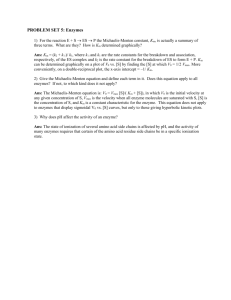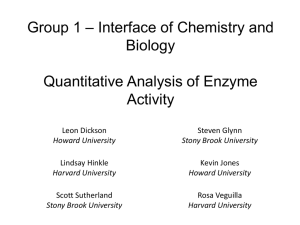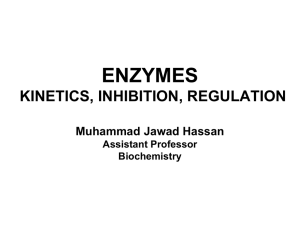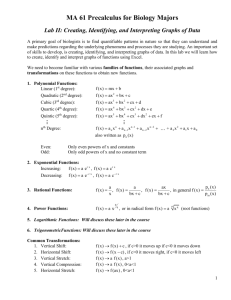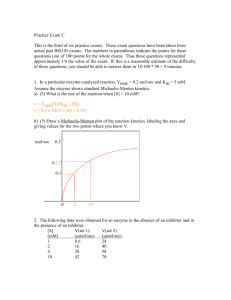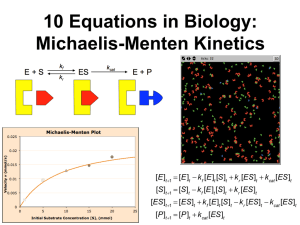Lesson 6. MICHAELIS-MENTEN KINETICS Objective
advertisement
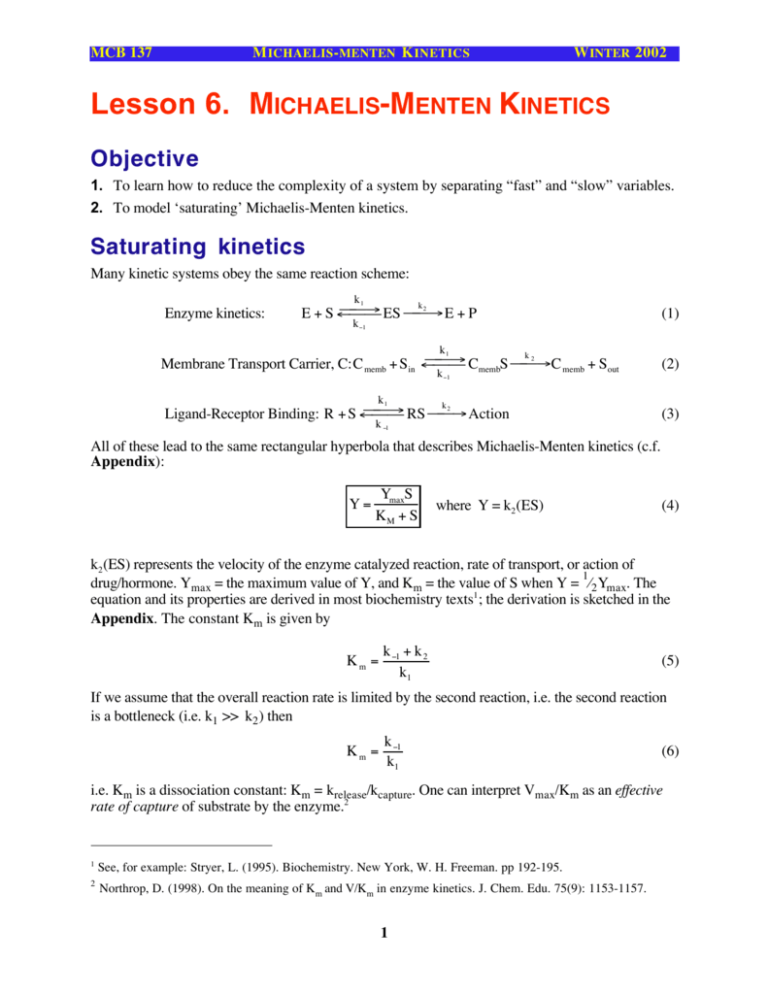
MCB 137 M ICHAELIS -MENTEN K INETICS W INTER 2002 Lesson 6. MICHAELIS-MENTEN KINETICS Objective 1. To learn how to reduce the complexity of a system by separating “fast” and “slow” variables. 2. To model ‘saturating’ Michaelis-Menten kinetics. Saturating kinetics Many kinetic systems obey the same reaction scheme: Enzyme kinetics: k1 k2 ææ æÆ E+S¨ æ ES ææÆ E + P k -1 k1 k2 ææ ææ Æ CmembS ææ Membrane Transport Carrier, C:C memb + Sin ¨ ÆC memb + Sout k (1) (2) -1 k1 k2 ææ ææ Æ RS ææ Ligand-Receptor Binding: R + S ¨ Æ Action k -1 (3) All of these lead to the same rectangular hyperbola that describes Michaelis-Menten kinetics (c.f. Appendix): Y= YmaxS KM + S where Y = k2 (ES) (4) k2 (ES) represents the velocity of the enzyme catalyzed reaction, rate of transport, or action of 1 drug/hormone. Ymax = the maximum value of Y, and Km = the value of S when Y = ⁄2 Ymax. The equation and its properties are derived in most biochemistry texts1 ; the derivation is sketched in the Appendix. The constant Km is given by Km = k -1 + k 2 k1 (5) If we assume that the overall reaction rate is limited by the second reaction, i.e. the second reaction is a bottleneck (i.e. k1 >> k2 ) then Km = k -1 k1 (6) i.e. Km is a dissociation constant: Km = krelease/kcapture. One can interpret Vmax/Km as an effective rate of capture of substrate by the enzyme.2 1 See, for example: Stryer, L. (1995). Biochemistry. New York, W. H. Freeman. pp 192-195. 2 Northrop, D. (1998). On the meaning of Km and V/Km in enzyme kinetics. J. Chem. Edu. 75(9): 1153-1157. 1 MM KINETICS Exercises Use Madonna to plot Equation (1) by writing the equation for Y directly into the Equation Window and setting S = TIME. Use the BATCH mode so that you can plot several different curves with different parameters. Start by holding Km constant at 10 mM for different values of Ymax, and show that Y = Ymax/2 only when S = Km. Next hold Ymax fixed at 10 and allow Km to vary. The higher the Km the slower the rise in Y—i.e. the longer it takes to get half way. In fact, Km = Y1/2. S Shaped (sigmoidal) Curves The reaction k1 k ææ æÆ nS + R ¨ æ Sn R ææ2 Æ Action k -1 (7) leads to Y= YmaxSn n (K m ) + Sn (8) Exercises 1. Plot this equation for different values of the parameters. Show that Ymax and Km retain the same significance as before(Ymax = the maximum value of Y, and Km = the value of S when Y = 1 ⁄2 Ymax), and that the larger the exponent, n, the larger the initial delay and the steeper the rise once it starts. 2. An inhibitor reacts with the with a mediator (enzyme, carrier, or receptor) and deactivates it. This reduces the total number of available mediators and leads to: YmaxK nm Y= n Km + Sn (9) Plot this equation as before for different values of the parameters.. Show that Ymax and Km retain their significance as before (Ymax = the maximum value of Y, and Km = the value of S when Y = 1/2 Ymax), and that larger the n the larger the initial delay and the steeper the fall once it starts. -2 - MM KINETICS ‘Stiff’ systems One of the most important methods of simplifying a complicated system is to separate the processes into ‘fast’ and ‘slow’ variables. The term arose from mechanical systems where ‘stiff’ springs respond very fast, while weak springs respond much more slowly. Then the displacement, z(t), can be broken into an initial ‘fast’ regime, followed by a long-time ‘slow’ regime. In many situations, we don’t care about the initial transient, but only on the long-time behavior. This is frequently the case in biochemical systems, where some reactions are fast and others are slow. The classical example is the Michaelis-Menten system, which we study below. Consider the simple system: d/dt (X) = Y - 2*X, INIT X = 1 d/dt (Y) = -100*(Y - X), INIT Y = 0 (10) Y(t) settles to its final value very fast, while X(t) decays much more slowly. Exercise Use the Rosenbrock “Stiff solver” with DT = 0.01 and DTMAX = 0.5 to solve the system (10). Notice that y(t) rises very fast at the beginning (zoom in and see!), and thereafter changes slowly, along with x(t). Suppose y changed so rapidly that it was always near its steady state: dy/dt = 0. They you could solve the second equation for y = x and substitute it into the first equation for x, so that it became dx/dt = -2x+x = -x. To see how good this approximation is, define a third variable, z by dz/dt = -x and plot it along with x and y. Now solve the same system using the Euler method. Turn on the data points with the button (•) and see how many more steps Madonna has to take to get a solution. Derivation of Michaelis-Menten Kinetics Transformation of a substrate, S, into a product, P, by an enzyme, E, proceeds by first forming an ‘activated complex’ C which then dissociates (almost irreversibly) into free enzyme and product, P: (Notation change: let C ≡ E⋅S denote the enzyme-substrate complex.) k1 k ææ æÆ E +S ¨ æ C ææ2 Æ E + P k -1 -3 - MM KINETICS These reactions can be written as the following set of differential equations:3 dE = k -1C + k 2 C - k1E ⋅S dt dS = k -1C - k1E ⋅S dt dC = k1E ⋅S - k -1C - k 2C = k1E ⋅S - (k -1 + k 2 )C dt (11) dP = k 2C dt An important common situation is when the enzyme, E, is saturated; i.e. it is working as fast as it can, so that k-1 >> k2, so that k2 is the ‘bottleneck’. Then the concentration of the E•S complex is nearly constant, so that we can set dC/dt ª 0, and C can be eliminated so that the system reduces to a single equation for the velocity of the reaction, V = -dS/dt: V =- dS V S = - max dt Km + S (12) Vmax!S k -1 + k 2 . The function V = Km!+!S is the Michaelis-Menten k1 hyperbola. Km is the value of S when the velocity of the reaction is half its maximum, Vmax, and the slope of the V(S) curve is Vmax/Km. where Vmax = k 2E Total K m = Exercise Simulate the Michaelis-Menten equations (11) in Madonna using k1 = 0.005, k2 = 0.005, k3 = 0.1 INIT S = 100, INIT P = 0, INIT E = 10, INIT C = 0 First use the Euler method with DT < 0.01. Then switch to the Rosenbrock (stiff) solver with DTMIN = 1e-6, DTMAX = 1, DTOUT = 0, and TOLERANCE = 1e-4. Use the Show Data button (•) on the graph to compare how efficient this integration method is to the Euler and Runge-Kutta. Use the Chemical Reaction Module (Menu: Model > Modules > Chemical Reactions…) to simulate the Michaelis-Menten system. 3 Not all of the differential equations are independent: adding the first two equations yields: E + C = ETotal (the total amount of enzyme is constant). Also, the last equation for P(t) is completely determined once C is known. Therefore, the four differential equations (11) can be reduced to only two independent differential equations. -4 -
